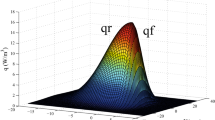Abstract
To improve the accuracy of finite element (FE) models used to simulate electric arc and beam-based fusion welding processes, a combined heat source model is proposed. The combined model, termed the polynomial heat source, is based on a Gaussian heat density distribution and employs a disc source to account for surface heating effects while a polynomial equation is used to define the volumetric heat power source. This provides an improved capability for matching the heat source power distribution to fusion zones having variable curvature and also results in a simplified process for defining heat source parameters as only three numerical values need to be determined. To validate the heat source model, fusion zone cross sections, thermal cycles, angular distortion, and residual stresses obtained using SYSWELD were compared to measurements taken from gas metal arc (GMA) welds made on 10-mm-thick high-strength low-alloy (HSLA) plates. Predictions obtained from SYSWELD using double ellipsoid and conical heat source models were also compared. An analysis of the FE predictions obtained from each of the three heat source models showed that the best agreement between simulated and experimental values was achieved using the polynomial model. This is attributed to the fact that heat power distribution can be adjusted at the top and bottom of the fusion zone and results in an improved level of bead cross section matching. It is expected that the proposed heat source model will be applicable for simulating both shallow and deep penetration welding processes where the fusion zone is symmetric about its centerline.
Similar content being viewed by others
References
Chen Y, He Y, Chen H, Zhang H, Chen S (2014) Effect of weave frequency and amplitude on temperature field in weaving welding process. Int J Adv Manuf Technol 75(5–8):803–813
Pavelic V, Tanbakuchi R, Uyehara O, Myers P (1969) Experimental and computed temperature histories in gas tungsten-arc welding of thin plates. Weld J 48(7):295s–305s
Rosenthal D (1946) The theory of moving sources of heat and its application to metal treatments. Trans Am Soc Mech Eng 43(11):849–866
Wenji L, Liangyu L, Jianfeng Y, Haihua L, Lei Y (2015) A kind of analytical model of arc welding temperature distribution under varying material properties. Int J Adv Manuf Technol 81(5):1109–1116
Goldak J, Chakravarti A, Bibby M (1984) A new finite element model for welding heat sources. Metall Mater Trans B 15(2):299–305
Paley Z, Hibbert P (1975) Computation of temperatures in actual weld designs. Weld J 54(11):385s–392s
Wu S, Zhao H, Wang Y, Zhang X (2004) A new heat source model in numerical simulation of high energy beam welding. Trans Chin Weld Inst 25(1):91–94
Li X, Wang L, Yang L, Wang J, Li K (2014) Modeling of temperature field and pool formation during linear laser welding of DP1000 steel. J Mater Process Technol 214(9):1844–1851
Bachorski A, Painter M, Smailes A, Wahab M (1999) Finite-element prediction of distortion during gas metal arc welding using the shrinkage volume approach. J Mater Process Technol 92:405–409
Chen Y, Han J, Li Z, Xia L, Yang Z (2014) An inverse method for searching parameters of combined welding heat source model. Inverse Prob Sci Eng 22(6):1009–1028
Faraji A, Goodarzi M, Seyedein S, Barbieri G, Maletta C (2015) Numerical modeling of heat transfer and fluid flow in hybrid laser–TIG welding of aluminum alloy AA6082. Int J Adv Manuf Technol 77(9–12):2067–2082
Meng X, Qin G, Su Y, Fu B, Ji Y (2015) Numerical simulation of large spot laser + MIG arc brazing–fusion welding of Al alloy to galvanized steel. J Mater Process Technol 222:307–314
Chukkan J, Vasudevan M, Muthukumaran S, Kumar R, Chandrasekhar N (2015) Simulation of laser butt welding of AISI 316L stainless steel sheet using various heat sources and experimental validation. J Mater Process Technol 219:48–59
Murphy A, Tanaka M, Yamamoto K, Tashiro S, Lowke J, Ostrikov K (2010) Modelling of arc welding: the importance of including the arc plasma in the computational domain. Vacuum 85(5):579–584
Carmignani C, Mares R, Toselli G (1999) Transient finite element analysis of deep penetration laser welding process in a singlepass butt-welded thick steel plate. Comput Methods Appl Mech Eng 179(3):197–214
Zhang L, Gao X, Sun M, Zhang J (2014) Weld outline comparison between various pulsed Nd: YAG laser welding and pulsed Nd:YAG laser–TIG arc welding. Int J Adv Manuf Technol 75(1–4):153–160
Li S, Chen G, Zhou C (2015) Effects of welding parameters on weld geometry during high-power laser welding of thick plate. Int J Adv Manuf Technol 79(1–4):177–182
Luo Y, You G, Ye H, Liu J (2010) Simulation on welding thermal effect of AZ61 magnesium alloy based on three-dimensional modeling of vacuum electron beam welding heat source. Vacuum 84(7):890–895
Wu C, Gao J (2002) Analysis of the heat flux distribution at the anode of a TIG welding arc. Comput Mater Sci 24(3):323–327
Xu G, Hu J, Tsai H (2009) Three-dimensional modeling of arc plasma and metal transfer in gas metal arc welding. Int J Heat Mass Transf 52(7):1709–1724
Li Y, Feng Y, Li Y, Zhang X, Wu C (2016) Plasma arc and weld pool coupled modeling of transport phenomena in keyhole welding. Int J Heat Mass Transf 92:628–638
Wang J, Han J, Domblesky J, Li W, Yang Z, Zhao Y (2015) Predicting distortion in butt welded plates using an equivalent plane stress representation based on inherent shrinkage volume. J Manuf Sci Eng 138(1):011012–011012
Yang Y, Athreya B (2013) An improved plasticity-based distortion analysis method for large welded structures. J Mater Eng Perform 22(5):1233–1241
Author information
Authors and Affiliations
Corresponding author
Rights and permissions
About this article
Cite this article
Wang, J., Han, J., Domblesky, J.P. et al. Development of a new combined heat source model for welding based on a polynomial curve fit of the experimental fusion line. Int J Adv Manuf Technol 87, 1985–1997 (2016). https://doi.org/10.1007/s00170-016-8587-3
Received:
Accepted:
Published:
Issue Date:
DOI: https://doi.org/10.1007/s00170-016-8587-3




